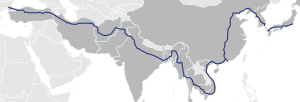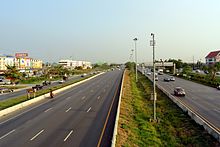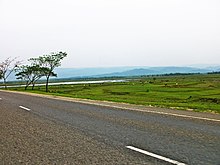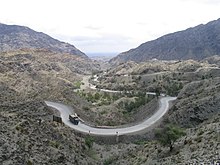AH1
This article needs additional citations for verification. (December 2015) |
 | ||||
|---|---|---|---|---|
 | ||||
| Route information | ||||
| Length | 20,557 km (12,774 mi) | |||
| Major junctions | ||||
| East end | Tokyo, Japan 35°41′03″N 139°46′29″E / 35.68417°N 139.77472°E | |||
| West end | Istanbul, Turkey 41°43′01″N 26°21′10″E / 41.71694°N 26.35278°E | |||
| Location | ||||
| Countries | Tokyo, Japan via South Korea, North Korea, China, Southeast Asia, Bangladesh, India, Pakistan, Afghanistan and Iran to the border between Turkey and Bulgaria west of Istanbul where it joins end-on with European route E80 | |||
| Highway system | ||||
Asian Highway Network
| ||||
Asian Highway 1 (AH1) is the longest route of the Asian Highway Network, running 20,557 km (12,774 mi) from Tokyo, Japan via Korea, China, Southeast Asia, Bangladesh, India, Pakistan, Afghanistan and Iran to the border between Turkey and Bulgaria west of Istanbul where it joins end-on with European route E80, running all the way to Lisbon, Portugal.
Japan[]

The 1200-kilometre[1] section in Japan was added to the system in November 2003.[2] It runs along the following tolled expressways:[3]
 Shuto Expressway C1 Inner Circular Route, Edobashi JCT to Tanimachi JCT via Takebashi JCT
Shuto Expressway C1 Inner Circular Route, Edobashi JCT to Tanimachi JCT via Takebashi JCT Shuto Expressway Route 3 Shibuya Line, Tanimachi JCT to Yoga Exit (Tokyo Interchange)
Shuto Expressway Route 3 Shibuya Line, Tanimachi JCT to Yoga Exit (Tokyo Interchange) Tōmei Expressway,[4] Tokyo Interchange to Komaki
Tōmei Expressway,[4] Tokyo Interchange to Komaki Meishin Expressway, Komaki to Suita via Kyoto
Meishin Expressway, Komaki to Suita via Kyoto Chūgoku Expressway, Suita to Kobe
Chūgoku Expressway, Suita to Kobe San'yō Expressway, Kobe to Hatsukaichi via Hiroshima
San'yō Expressway, Kobe to Hatsukaichi via Hiroshima Hiroshima Expressway (urban expressway), Hatsukaichi to Hatsukaichi Route 1
Hiroshima Expressway (urban expressway), Hatsukaichi to Hatsukaichi Route 1 National Route 2 Hatsukaichi to Iwakuni
National Route 2 Hatsukaichi to Iwakuni San'yō Expressway, Iwakuni to Yamaguchi
San'yō Expressway, Iwakuni to Yamaguchi Chūgoku Expressway, Yamaguchi to Shimonoseki
Chūgoku Expressway, Yamaguchi to Shimonoseki Kanmon Bridge, Shimonoseki to Kitakyushu
Kanmon Bridge, Shimonoseki to Kitakyushu Kyushu Expressway, Kitakyushu to Fukuoka
Kyushu Expressway, Kitakyushu to Fukuoka Fukuoka Expressway Route 4
Fukuoka Expressway Route 4 Fukuoka Expressway Route 1
Fukuoka Expressway Route 1
![]() Camellia Line ferry to Busan, South Korea.
Camellia Line ferry to Busan, South Korea.
From Fukuoka, the Japan–Korea Undersea Tunnel has been proposed to provide a fixed crossing.
South Korea[]

The section in South Korea mainly follows the Gyeongbu Expressway. The Highway Boundary of South and North Korea.
 : Busan-Centre - Busan-Dong-gu
: Busan-Centre - Busan-Dong-gu Busan City Route 11: Busan-Dong-gu - Busan-Geumjeong-gu
Busan City Route 11: Busan-Dong-gu - Busan-Geumjeong-gu Gyeongbu Expressway: Busan-Geumjeong-gu - Gyeongju - Daegu - Daejeon - Seoul-Seocho-gu
Gyeongbu Expressway: Busan-Geumjeong-gu - Gyeongju - Daegu - Daejeon - Seoul-Seocho-gu Seoul City Route 41: Seoul-Seocho-gu - Seoul-Gangnam-gu - Seoul-Yongsan-gu
Seoul City Route 41: Seoul-Seocho-gu - Seoul-Gangnam-gu - Seoul-Yongsan-gu Namsan 1st tunnel: Seoul-Yongsan-gu - Seoul-Jung-gu
Namsan 1st tunnel: Seoul-Yongsan-gu - Seoul-Jung-gu Seoul City Route 21: Seoul-Jung-gu - Seoul-Eunpyeong-gu
Seoul City Route 21: Seoul-Jung-gu - Seoul-Eunpyeong-gu National Route 1: Seoul-Eunpyeong-gu - Panmunjeom
National Route 1: Seoul-Eunpyeong-gu - Panmunjeom
North Korea[]
- P'anmunjŏm - Kaesŏng
 Pyongyang-Kaesong Motorway: Kaesŏng - P'yŏngyang
Pyongyang-Kaesong Motorway: Kaesŏng - P'yŏngyang Pyongyang-Sinuiju Motorway (Under Construction): P'yŏngyang - Sinŭiju
Pyongyang-Sinuiju Motorway (Under Construction): P'yŏngyang - Sinŭiju
China[]
- Within Dandong: New Yalu River Bridge - Binjiang Middle Road (
 G228) - Chunsan Road - People's Square roundabout - Jinshan Street - Huayuan Road (
G228) - Chunsan Road - People's Square roundabout - Jinshan Street - Huayuan Road ( G301)
G301)  G1113: Dandong - Shenyang (Xiashengou JCT)
G1113: Dandong - Shenyang (Xiashengou JCT)- Within Shenyang:
 : Xiashengou JCT - Jinbaotai JCT - Beiliguan JCT
: Xiashengou JCT - Jinbaotai JCT - Beiliguan JCT  G1: Shenyang (Beiliguan JCT) - Beijing (Shiyuan JCT)
G1: Shenyang (Beiliguan JCT) - Beijing (Shiyuan JCT)- Within Beijing:
 G4501: Shiyuan JCT - Maju JCT - Shuangyuan JCT - Fangshan Liyuan JCT
G4501: Shiyuan JCT - Maju JCT - Shuangyuan JCT - Fangshan Liyuan JCT  G4: Beijing (Fangshan Liyuan JCT) - Shijiazhuang - Zhengzhou - Xinyang - Wuhan - Changsha - Guangzhou (Taihe JCT)
G4: Beijing (Fangshan Liyuan JCT) - Shijiazhuang - Zhengzhou - Xinyang - Wuhan - Changsha - Guangzhou (Taihe JCT)- Within Guangzhou:
 : Taihe JCT - Longshan JCT - Leping JCT - Hengjiang JCT
: Taihe JCT - Longshan JCT - Leping JCT - Hengjiang JCT  G80: Guangzhou - Nanning
G80: Guangzhou - Nanning G7211: Nanning - Youyiguan
G7211: Nanning - Youyiguan
Guangzhou - Hong Kong branch[]
 : Taihe JCT - Huocun JCT
: Taihe JCT - Huocun JCT G4: Guangzhou (Huocun JCT) - Dongguan - Shenzhen
G4: Guangzhou (Huocun JCT) - Dongguan - Shenzhen
Hong Kong[]
Guangzhou - Hong Kong branch[]
 Route 10, Shenzhen Bay Port - Shenzhen Bay Bridge - Lam Tei
Route 10, Shenzhen Bay Port - Shenzhen Bay Bridge - Lam Tei Route 9, Lam Tei - Yuen Long Highway - San Tin Highway - Huanggang Port
Route 9, Lam Tei - Yuen Long Highway - San Tin Highway - Huanggang Port
Vietnam[]

 : Hữu Nghị Quan - Đồng Đăng - Hanoi - Vinh - Đồng Hới - Đông Hà - Huế - Đà Nẵng - Hội An - Quy Nhơn - Nha Trang - Phan Thiết - Biên Hòa - Ho Chi Minh
: Hữu Nghị Quan - Đồng Đăng - Hanoi - Vinh - Đồng Hới - Đông Hà - Huế - Đà Nẵng - Hội An - Quy Nhơn - Nha Trang - Phan Thiết - Biên Hòa - Ho Chi Minh : Ho Chi Minh - Mộc Bài
: Ho Chi Minh - Mộc Bài
Cambodia[]
Thailand[]


 : Aranyaprathet - Kabin Buri -
: Aranyaprathet - Kabin Buri -  Route 1: - Bang Pa In
Route 1: - Bang Pa In Route 32: - Bang Pa In - Chai Nat (Concurrent with
Route 32: - Bang Pa In - Chai Nat (Concurrent with  AH2)
AH2) Route 1: Chai Nat - Tak (Concurrent with
Route 1: Chai Nat - Tak (Concurrent with  AH2)
AH2) : Tak - Mae Sot
: Tak - Mae Sot
Myanmar[]
- National Highway 8: Myawaddy -
- Branch Yangon–Mandalay Expressway : - Yangon
- Yangon–Mandalay Expressway: - Meiktila - Mandalay
- : (Concurrent with
 AH2): Mandalay - Tamu
AH2): Mandalay - Tamu
India (East)[]
 NH 102: Moreh - Imphal
NH 102: Moreh - Imphal NH 37: Imphal - Kohima
NH 37: Imphal - Kohima NH 29: Kohima - Dimapur - Doboka
NH 29: Kohima - Dimapur - Doboka NH 27: Doboka - Nagaon - Jorabat
NH 27: Doboka - Nagaon - Jorabat NH 6: Jorabat - Shillong
NH 6: Jorabat - Shillong NH 206: Shillong - Dawki
NH 206: Shillong - Dawki
Bangladesh[]

 N2: Tamabil, Sylhet - Sylhet - - Dhaka
N2: Tamabil, Sylhet - Sylhet - - Dhaka N8: Dhaka-Mawa-Bhanga Expressway
N8: Dhaka-Mawa-Bhanga Expressway : Bhanga, Faridpur - Alipur, Faridpur
: Bhanga, Faridpur - Alipur, Faridpur : Alipur, Faridpur - Goalchamot, Faridpur
: Alipur, Faridpur - Goalchamot, Faridpur N7: Faridpur - Jessore
N7: Faridpur - Jessore : Jessore - Benapole[5]
: Jessore - Benapole[5]
India (West)[]


 NH 112: Petrapole - Barasat
NH 112: Petrapole - Barasat NH 12: Barasat - Kolkata Airport
NH 12: Barasat - Kolkata Airport- Belghoria Expressway: Kolkata Airport - Dankuni
 NH 19: Dankuni - Durgapur -Asansol - Dhanbad -Barhi - Mohania - Varanasi - Allahabad - Kanpur - Agra - New Delhi
NH 19: Dankuni - Durgapur -Asansol - Dhanbad -Barhi - Mohania - Varanasi - Allahabad - Kanpur - Agra - New Delhi NH 44: New Delhi - Sonipat - Ambala - Jalandhar
NH 44: New Delhi - Sonipat - Ambala - Jalandhar NH 3: Jalandhar - Amritsar - Attari
NH 3: Jalandhar - Amritsar - Attari
Pakistan[]

- Grand Trunk Road, Wagah — Lahore
 Lahore — Islamabad
Lahore — Islamabad Islamabad — Peshawar
Islamabad — Peshawar Peshawar — Torkham
Peshawar — Torkham
Afghanistan[]
- Afghanistan Ring Highway: Jalalabad - Kabul - Kandahar - Delaram - Herat - Islam Qala
Iran[]
 : Islam Qala - Taybad
: Islam Qala - Taybad : Taybad- Sang Bast
: Taybad- Sang Bast : Sang Bast - Shahrood - Damghan - Semnan - Tehran
: Sang Bast - Shahrood - Damghan - Semnan - Tehran
 : Tehran - Qazvin - Tabriz
: Tehran - Qazvin - Tabriz : Tabriz - Bazargan
: Tabriz - Bazargan
Turkey[]
 D.100 Road D100: Gürbulak - Doğubayazıt - Aşkale - Refahiye
D.100 Road D100: Gürbulak - Doğubayazıt - Aşkale - Refahiye D.200 Road D200: Refahiye - Sivas - Ankara
D.200 Road D200: Refahiye - Sivas - Ankara O-4 Otoyol 4: Ankara - Gerede - İstanbul
O-4 Otoyol 4: Ankara - Gerede - İstanbul O-7 Otoyol 7: İstanbul
O-7 Otoyol 7: İstanbul O-3 Otoyol 3: İstanbul - Edirne - - Kapıkule (
O-3 Otoyol 3: İstanbul - Edirne - - Kapıkule ( Bulgaria,
Bulgaria,  Maritsa motorway)
Maritsa motorway)
Connection to E80[]

The route AH1 is also marked as ![]() E 80 in Turkey. The E80 continues in the E-road network from the border station at Kapitan Andreevo/Kapıkule to Sofia in Bulgaria, followed by E80 highways to Niš, Pristina, Dubrovnik, Pescara, Rome, Genoa, Nice, Toulouse, Burgos, Valladolid, Salamanca and finally Lisbon on the Atlantic Ocean.
E 80 in Turkey. The E80 continues in the E-road network from the border station at Kapitan Andreevo/Kapıkule to Sofia in Bulgaria, followed by E80 highways to Niš, Pristina, Dubrovnik, Pescara, Rome, Genoa, Nice, Toulouse, Burgos, Valladolid, Salamanca and finally Lisbon on the Atlantic Ocean.
References[]
| Wikimedia Commons has media related to AH1. |
- ^ Economic and Social Commission for Asia and the Pacific, 2003 Asian Highway Handbook Archived 2012-04-14 at the Wayback Machine, 2003, page 54
- ^ Economic and Social Commission for Asia and the Pacific, 2003 Asian Highway Handbook Archived 2012-04-14 at the Wayback Machine, 2003, page 3
- ^ アジアハイウェイ標識の設置場所 (in Japanese). MLIT. Retrieved December 5, 2011.
- ^ Economic and Social Commission for Asia and the Pacific,2003 Asian Highway Handbook Archived 2012-04-14 at the Wayback Machine, 2003, page 54 shows an aerial photo of the Yokohama Aoba Interchange, placing AH1 clearly on the Tomei Expressway rather than the other Tokyo-Nagoya expressway, the Chūō Expressway.
- ^ "Archived copy" (PDF). Archived from the original (PDF) on 2017-10-13. Retrieved 2009-01-26.CS1 maint: archived copy as title (link)
- AH1
- Asian Highway Network
- Transport in Iran
- Transport in North Korea
- Roads in China
- Transport in Cambodia
- Transport in Myanmar
- Transport in Japan
- Roads in Afghanistan
- Roads in Myanmar
- Roads in Iran
- Roads in Japan
- Roads in Turkey
- Roads in North Korea
- Roads in South Korea
- Roads in Vietnam
- Roads in Cambodia
- Roads in Thailand
- Roads in India
- Roads in Pakistan
- Roads in Bangladesh
- Transport in Vietnam
- Highways in Bangladesh



